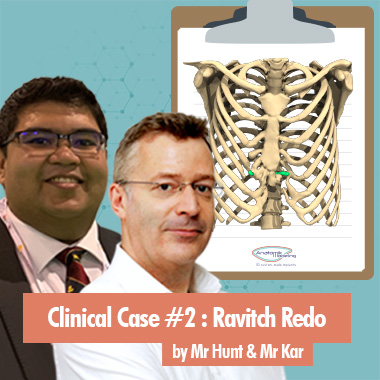Mr Ian Hunt and Mr Ashok Kar, Experts cardio-thoracique du Pectus
M. Ian Hunt, BSc (Hons) MBBS MRCS FRCS (CTh), est le directeur médical de la Pectus Clinic à Londres, chirurgien thoracique et principal consultant clinique pour le département de chirurgie thoracique, division de chirurgie cardiothoracique et vasculaire, à l'Hôpital St. George's NHS Trust et à l'hôpital Spire St. Anthony. En même temps, il est maître de conférences honoraire à la St. George's Medical School de l'Université de Londres et consultant honoraire au Royal Marsden Hospital de Londres. Enfin, il est membre ou ancien membre du General Medical Council (GMC), du Royal College Surgeons of England (RCS), du Chest Wall International Group (CWIG), de la Chest Wall Injury Society (CWIS) et bien plus encore.
Le chirurgien thoracique s'intéresse activement aux traumatismes thoraciques et est un expert internationalement reconnu des déformations de la paroi thoracique et des pectus. Il est activement impliqué dans la recherche clinique, la formation et l'éducation aux niveaux universitaire et postuniversitaire. Il a plus de 150 présentations, articles et publications à son actif et a parlé lors de nombreuses conférences nationales et internationales sur une grande variété de sujets de chirurgie thoracique.
M. Hunt, en collaboration avec M. David Gateley, un chirurgien plasticien expérimenté, et sous la direction et le soutien du professeur Chavoin, a effectué près de 50 procédures d'implants de Pectus Excavatum, avec environ 25% des patients ayant déjà subi une opération du Pectus préalable (Nuss ou Ravitch).
M. Ashok Kar, BA (Hons), MB BChir, MA (Cantab), MRCS (Eng), FRCS (CTh), est chef de clinique spécialiste en chirurgie cardio-thoracique (ST8), diplômé de la London School of Surgery et St George's Hospital NHS Trust. Il est membre ou ancien membre du General Medical Council (GMC), de la Society of Cardiothoracic of UK & Ireland (SCTS), du Cardiothoracic Surgery Network (CTSNet) et bien plus encore.
M. Ashok Kar est un chef de clinique résident en chirurgie cardio-thoracique avec un intérêt pour les traumatismes et les déformations de la paroi thoracique. Il a reçu plusieurs prix nationaux au cours de sa formation en chirurgie cardio-thoracique et a fait des présentations internationales aux réunions annuelles de l'Association Américaine de Chirurgie Thoracique et de la Société Européenne de Chirurgie Thoracique sur les techniques innovantes liées à la procédure de Nuss.
Cas clinique: Implants après échec de la technique dérivée de Ravitch pour Pectus Excavatum
Scénario clinique
Sexe: Masculin
Age: 22 ans
Contexte: Correction chirurgicale d'un Ravitch modifié antérieur (avec la technique du hamac) pour Pectus Excavatum asymétrique sévère
Présentation
Ce jeune patient de sexe masculin ne présentait aucun symptôme physique de son thorax en entonnoir mais avait souffert de son apparence au cours de son adolescence.
Il a été soumis à une batterie de tests de la fonction pulmonaire et cardiaque qui n'a montré aucune altération physiologique significative. Il n'avait pas d'autres antécédents médicaux notables.
En 2017, il a subi une correction chirurgicale de sa déformation sévère du Pectus avec une approche de Ravitch modifié avec l'utilisation d'un hamac en prolène plutôt qu'une barre métallique pour maintenir la correction sternale. La technique consiste à utiliser une longueur de maille de prolène enroulée dans un tube puis placée sous le sternum libéré comme point le plus bas. Le maillage est ensuite solidement ancré à la cage thoracique de chaque côté après avoir été tiré fermement pour soulever le sternum. La technique de l'élingue ou du hamac a été décrite pour la première fois par Robicsek [1999, réf. 1].
Après la résection du cartilage pendant une procédure de type Ravitch, le sternum est accroché avec un hamac constitué d'une maille Marlex. La technique est devenue populaire parmi les chirurgiens thoraciques car elle ne nécessite pas de 2e opération pour retirer une barre métallique généralement utilisée pour maintenir le sternum après une procédure Ravitch plus classique.
Après la chirurgie, il a récupéré sans incident, mais le patient a signalé une récidive rapide de son Pectus Excavatum en quelques semaines. Le patient est venu me consulter pour un deuxième avis avec constatation d'un thorax en entonnoir résiduel modéré, presque sévère, relativement asymétrique, vers la droite.
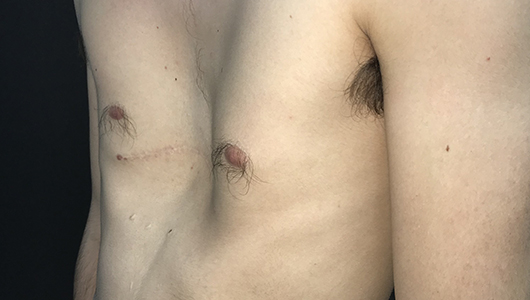
Investigations
Une tomodensitométrie répétée a été réalisée démontrant un indice de Haller de 6,7, malgré une correction chirurgicale antérieure de la déformation thoracique.
Des reconstructions détaillées de sa poitrine ont été effectuées dans le cadre de son évaluation. Le patient souhaitait éviter une nouvelle chirurgie correctrice qui aurait nécessité une révision de la procédure de Ravitch modifié et l'ablation de la maille en prolène avec des risques accrus de complications en raison de cicatrices intra-pleurales incertaines et d'adhérences derrière le sternum.
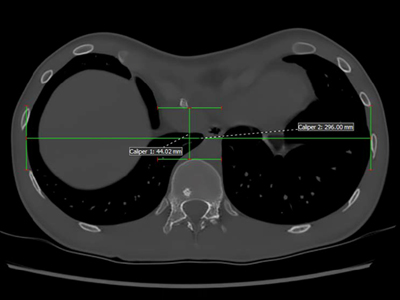

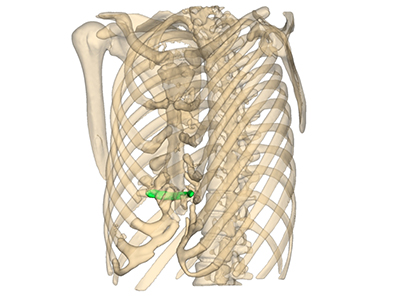
Traitement supplémentaire proposé
Le patient a opté pour un implant en silicone 3D sur-mesure avec son chirurgien. L'implant a été spécialement conçu pour le patient grâce à la reconstruction osseuse et musculaire en images 3D de son scanner. L'implant désigné et produit est discret, relativement petit (458 cm3 en volume) mais assez profond (4cm de profondeur).
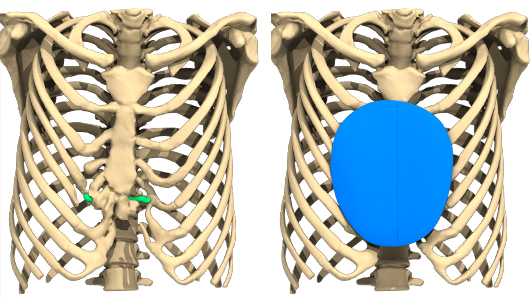
Procédure d'implantation chirurgicale
Le patient a subi son opération d'implant personnalisé de Pectus en Avril 2018. L'opération a été réalisée en ambulatoire avec un chirurgien thoracique et un chirurgien plasticien dédiés. Conformément aux instructions d'AnatomikModeling, l'implant a été préalablement positionné sur le torse du patient en respectant les points de repères osseux indiqués et le marquage du gabarit de ce dernier.
Une incision sternale transversale a été réalisée à travers l'incision précédente sur la déformation. Les tissus mous, y compris le grand pectoral, ont été disséqués bilatéralement de la déformation.
Une poche superficielle entre le muscle pectoral, le sternum et la paroi thoracique antérieure profonde a été créée. L'hémostase a été régulée avec sécurité et l'implant excellement ajusté et fixé aux tissus mous. Le patient a eu une récupération post-opératoire sans incident et a été libéré le même jour, avec un drain Redivac. Celui-ci a ensuite été retiré 12 jours plus tard lors du suivi clinique.
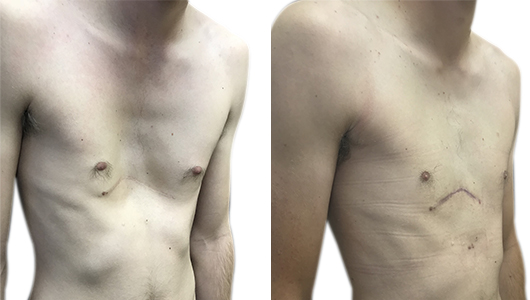
Résultats
Un excellent résultat cosmétique a été obtenu grâce à l'implant pour corriger la déformation du Pectus et l'asymétrie de la paroi thoracique. Le patient était entièrement satisfait du résultat final et n'a plus eu besoin de consultation de suivi après 3 mois.
Photo à gauche: Photos prises deux mois après la procédure d'implantation de l'implant pour corriger le creux résiduel.
Témoignage du patient
“Après avoir eu un Ravitch …… j'étais encore affecté par mon pectus, m'empêchant d'avancer dans la vie. Avec l'implant pour pectus, je me sens normal et très heureux d'avoir décidé de faire cette nouvelle correction”
Conclusions
Parfois, le résultat après une opération corrective peut être insatisfaisant - une technique Ravitch modifiée qui utilise une technique d'élingue ou de hamac peut éviter une 2e opération pour retirer la barre métallique mais peut être associée à un risque de déformation récurrente précoce du thorax en entonnoir. Une reprise chirurgicale orthopédique dans ces situations peut être associée à des risques opératoires plus importants et à des complications post-opératoires.
Ce cas met en évidence qu'un implant de Pectus en chirurgie secondaire peut être utilisé dans ce contexte clinique avec d'excellents résultats, une récupération sans incident et sans besoin d'intervention supplémentaire.
Source et Bibliographie
Source
Bibliographie
Patel AJ, Hunt I. Initial Reduction of flexible Pectus Carinatum with Outpatient Manipulation as an adjunct to External Compressive Bracing: Technique and Early Outcomes at 12 weeks. J Pediatr Surg. 2019 Nov 1. pii: S0022-3468(19)30672-4. doi: 10.1016/j.jpedsurg.2019.09.024. [Epub ahead of print] PubMed PMID: 31708203.
Fraser S, Harling L, Patel A, Richards T, Hunt I. External Compressive Bracing with Initial Reduction of Pectus Carinatum: Compliance is the Key. Ann Thorac Surg. 2019 Sep 23. pii: S0003-4975(19)31411-0. doi: 10.1016/j.athoracsur.2019.08.026
Patel AJ, Hunt I. Is Vacuum Bell therapy effective in the correction of pectus excavatum? Interact Cardiovasc Thorac Surg. 2019 Mar 28. pii: ivz082. doi: 10.1093/icvts/ivz082.
Patel AJ, Hunt I. Effectiveness of Compressive External Bracing in Patients with flexible Pectus Carinatum Deformity: A review. Thorac Cardiovasc Surg. 2019 Apr 25. doi: 10.1055/s-0039-1687824. [Epub ahead of print] PMID: 31022736

